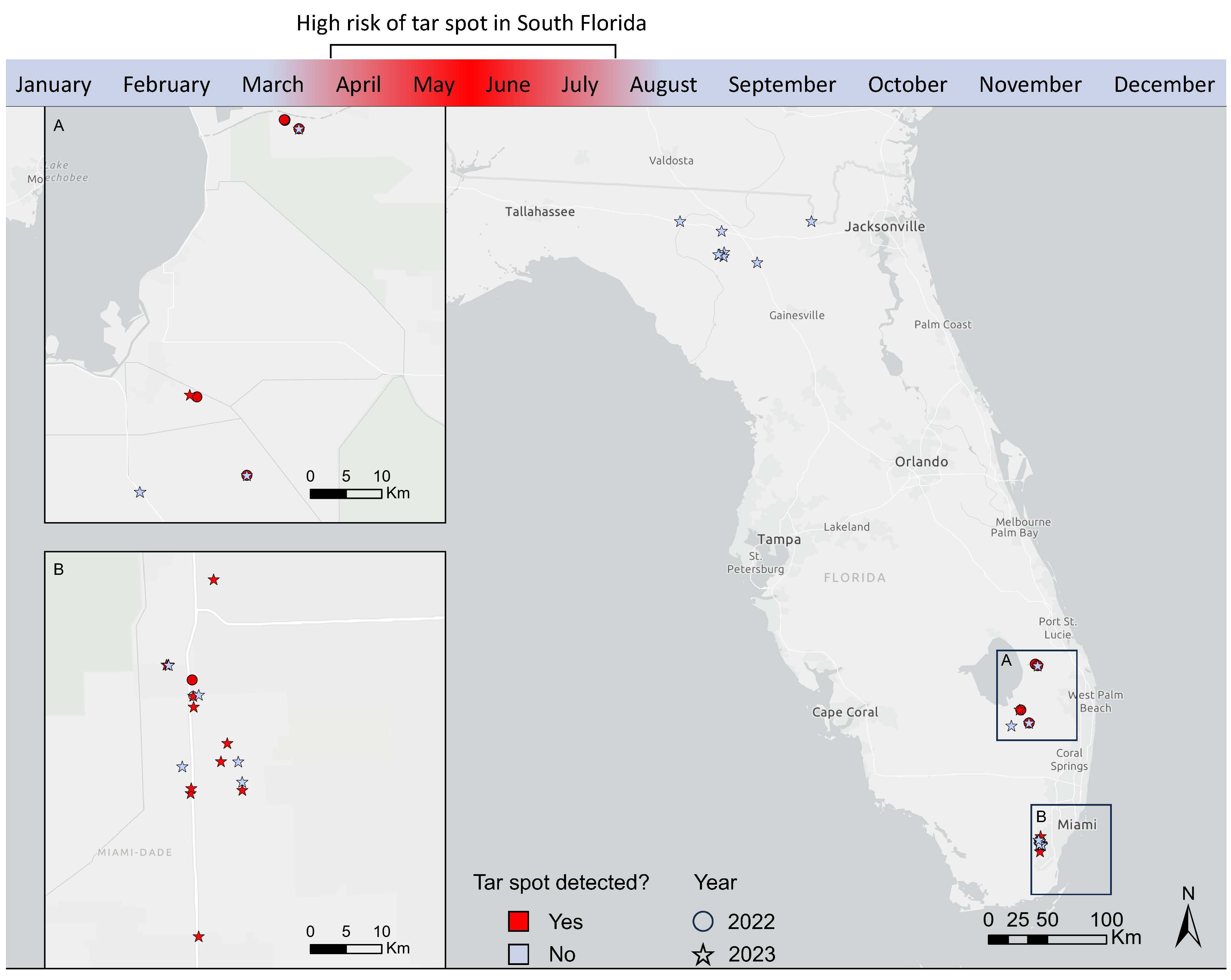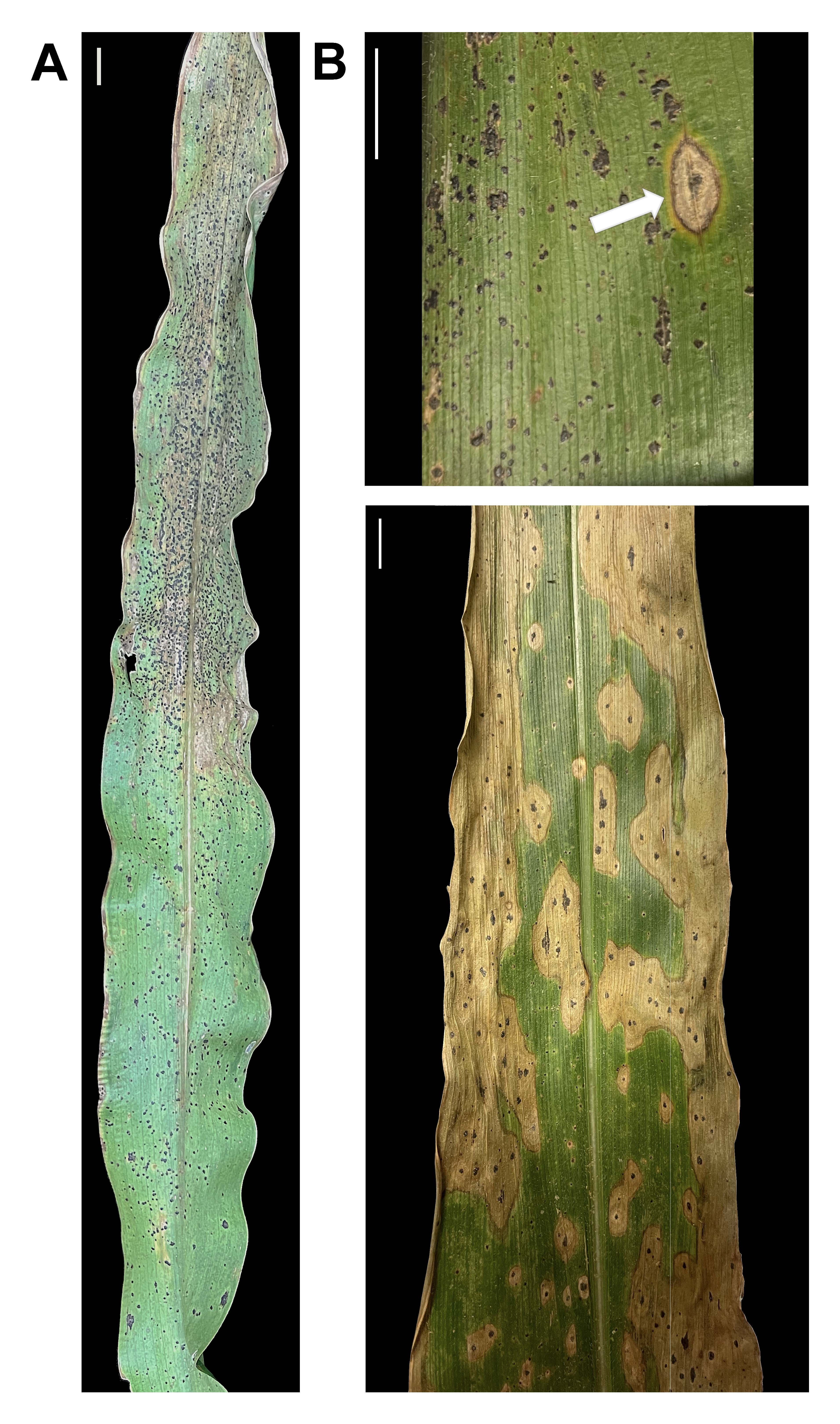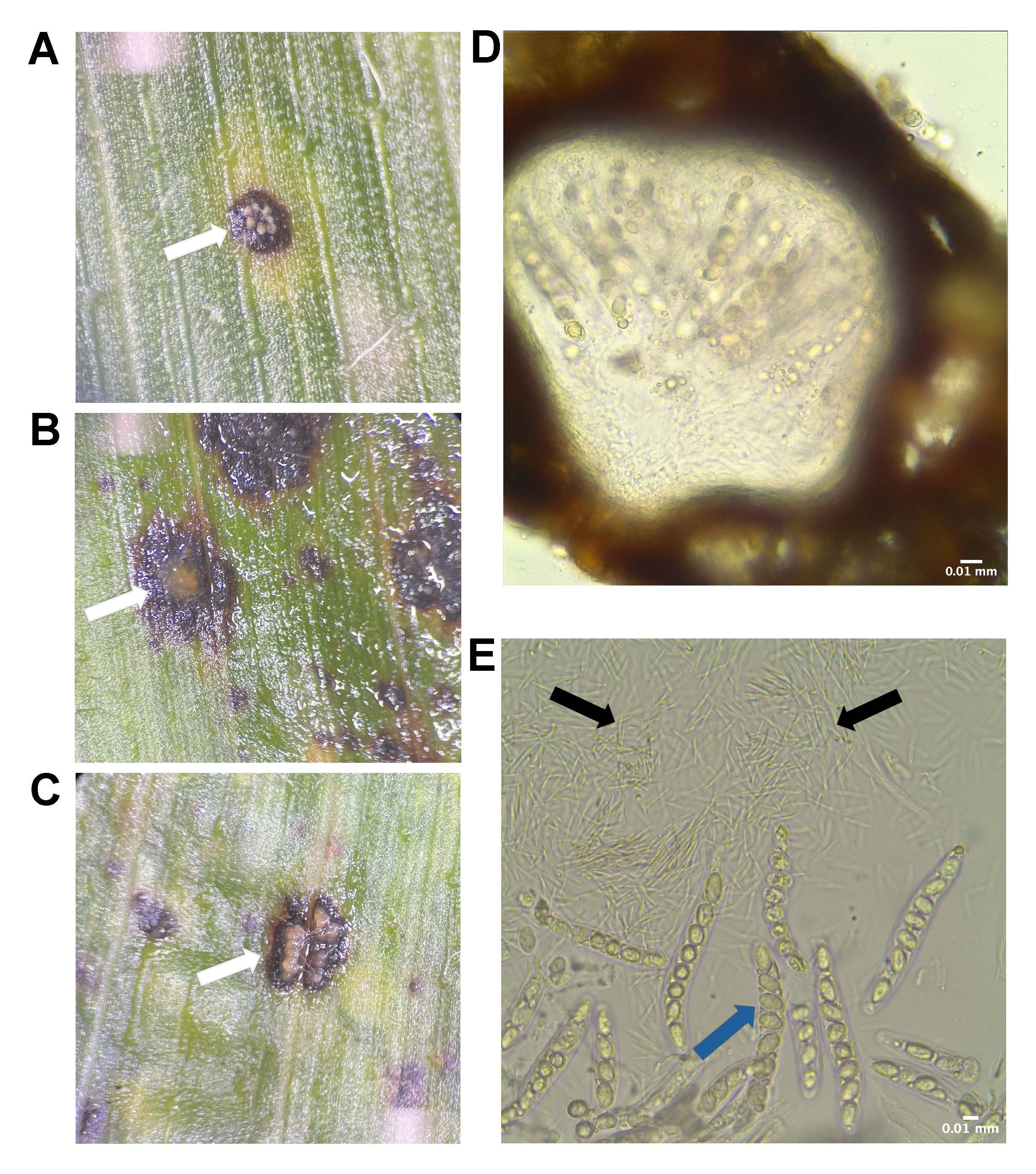Abstract
Tar spot, a fungal foliar disease, affects most maize types commonly grown in Florida, such as sweet corn, field corn, and criollo corn. This disease is characterized by brown-to-black, raised structures called stromata, which are embedded in leaf tissue. As a polycyclic disease, tar spot lesions can increase in number as the disease progresses throughout the growing season, leading to reduction of photosynthetic area on the leaves. Tar spot has recently emerged as a significant threat in Florida and in the United States, with reports of up to 100% incidence in maize fields in south Florida. Tar spot occurrence and development in Florida is influenced by several factors, such as environmental conditions, maize types, crop maintenance, and corn growth stages. The purpose of this publication is to promote awareness among Florida growers regarding this newly identified disease and its management practices.
Introduction
Florida is one of the major producers of sweet corn for fresh market in the United States, and this crop is the fourth most important vegetable to the state’s economy. In 2022, the production of sweet corn totaled 261,095 tons, generating $219,842,000 (USDA-NASS 2023). In 2023, Florida’s silage and grain production also represented significant importance to the state, yielding 475,000 and 274,288 tons, respectively (USDA-NASS 2024). Sweet corn is primarily grown in south Florida as a winter vegetable, between October and May, whereas criollo corn is cultivated year-round in the region for local consumption. The production of corn grain and silage (referred to as “field corn”) is concentrated in central and north Florida between February and August (Wright et al. 2022).
Tar spot, primarily caused by the fungal pathogen Phyllachora maydis, has become a concerning issue for maize growers in the United States. The first documented cases of tar spot disease in the United States occurred in Illinois and Indiana in 2015 (Ruhl et al. 2016), followed by its detection in Florida in 2016 (McCoy et al. 2018). Tar spot affects maize plants irrespective of their cultivation purposes, thus posing a significant risk to the agricultural sector in Florida. The economic damage caused by tar spot has raised alarms among agricultural communities, as it became the topmost destructive foliar disease in field corn in the United States and Canada (Mueller et al. 2023). Yield losses estimated at 116.8 million bushels have been reported in affected regions in 2022, jeopardizing the profitability and sustainability of field corn production systems.
In recent years, Florida has experienced a surge in tar spot cases, with reports of 100% incidence in field corn fields, particularly in the southern regions (Moura et al. 2023b). This alarming development has raised concerns among the scientific community, as the disease has led to significant yield reduction and quality deterioration in the Midwest. The impacts of tar spot on field and sweet corn production in Florida are still unknown. Understanding the current situation and trends of tar spot disease in Florida is crucial, especially in anticipation of a potential epidemic that could impact maize production in the state.
History of Tar Spot in Florida
Tar spot was first observed in 2016 in Palm Beach County, southern Florida, in experimental field corn nurseries used for screening inbred lines and hybrids by UF/IFAS and seed companies. By 2019, the disease was also observed in commercial sweet corn fields, specifically in Palm Beach, Hendry, and Miami-Dade counties (Corn IPM Pipe n.d.). In 2021, tar spot was observed for the first time in north Florida (R. Raid, personal communication). Based on surveys conducted in 2022 and 2023 across Florida, tar spot occurred consistently between April and July of each year (Moura et al. 2023b), which is notably late in Florida’s sweet corn growing season (Figure 1). Throughout both years, tar spot was detected in plants in early vegetative stages (V6) to full maturity (R6), with severity peaking in plants post-tasseling. In 2022, tar spot severity reached up to 25% in field corn in Palm Beach County. Contrasting this, in 2023, commercial sweet corn fields exhibited tar spot severity levels below 1%. The wide-ranging disparity in disease levels observed between the two years and across geographical locations suggests the influence of other factors on tar spot dynamics including environment, crop maintenance, maize variety, and growth stages.

Credit: L. C. Ferreira, UF/IFAS
Disease Etiology and Symptoms
Typical symptoms of tar spot manifest as distinct dark-brown to black, protruding spots on maize leaves, giving them a rough appearance. These spots, denominated stroma (plural: stromata), are firmly embedded within the leaf tissue, resisting removal when scratched (Figure 2A). Stromata can expand along the leaf veins, taking on an oblong shape (Solórzano et al. 2023). Another symptom associated with this disease is called "fish-eye" (Figure 2B), in which a stroma is surrounded by a necrotic halo. Maize plants at tasseling or later reproductive stages tend to be more severely affected by tar spot than plants at the early vegetative growth stages, which usually have very low disease levels even when planted side-by-side with older plants that are heavily affected, based on our survey. The disease symptoms on the same plant often follow a bottom-up pattern, with older leaves showing the first symptoms and being most affected. Tar spot symptoms may also appear as dark-brown to black, protruding spots on leaf sheaths and husks (Bajet, Renfro, and Carrasco 1994). As the disease progresses on leaves, there is a reduction in the green photosynthetic area, and at high severity levels, leaves can undergo premature senescence, which is the early aging and death of plant tissue. This progression ultimately leads to yield loss, with reduced ear weight and premature germination of seeds before reaching maturity both being linked to tar spot (Dittrich et al. 1991; Hock, Kranz, and Renfro 1995).

Credit: L. C. Ferreira, UF/IFAS
Stromata of P. maydis also serve as reproductive structures for the fungus, harboring both sexual and asexual spores (Figure 3). Notably, only the sexual spores (named ascospores) are known to be infectious and initiate disease development. In conditions of high humidity, a noticeable mass exudate is often observed over the stroma. This mucilaginous mass exhibits variations in color, ranging from white-translucent to yellow or orangish, and contains P. maydis ascospores (Figure 3). Additional fungal species, such as Fusarium spp. and Coniothyrium phyllachorae, are commonly associated with tar spot stroma, contributing to what is known as the tar spot complex.

Credit: L. C. Ferreira and V. A. S. Moura, UF/IFAS
Disease Cycle
Phyllachora maydis, as an obligate biotrophic pathogen, depends on a living organism to absorb nutrients and complete its developmental cycle (Figure 4). The host colonization begins after an ascospore is deposited on the leaf surface. Subsequently, it germinates, infecting the host epidermal cells, which the hyphae colonize (Caldwell et al. 2023). Reproductive structures, specifically pycnidium and perithecium, form and produce conidia and ascospores, respectively. Under favorable conditions, these spores are released onto the leaf surface, with the ascospores being able to disseminate and infect nearby cells on the same leaf or be dispersed to continue the cycle. Successful colonization leads to the development of typical symptoms, usually observed between 14–21 days after infection. While P. maydis survives in crop debris during winter in the Midwest (Kleczewski, Donnelly, and Higgins 2019), its survival in tillage crop debris during summer in south Florida is limited (V. Moura, unpublished data), coinciding with the tail-end of the corn growing season in the region.
The climatic conditions influencing the development of P. maydis stromata differ between regions, notably in the Midwest and Florida. In the Midwest, the growth of P. maydis stromata is driven by prolonged periods of moderate ambient temperature (18°C–23°C), coupled with short periods of high relative humidity (> 90%) (Webster et al. 2023). Interestingly, Florida experienced 248 days in 2022 and 147 days in 2023 with daily relative humidity exceeding 90%, according to the data collected by FAWN weather stations (Peeling et al. 2023). This variation in humidity between the two regions highlights the diverse environmental factors influencing tar spot dynamics. Additionally, the El Niño and La Niña phenomena play a role in shaping weather parameters, affecting regions like Florida. While direct evidence linking these climatic changes to tar spot incidence and severity is currently lacking, understanding their potential impacts is crucial for ongoing tar spot epidemiology studies in Florida.
![Figure 4 Tar spot disease cycle in Florida. Phyllachora maydis spores can be dispersed by wind. Once an ascospore falls onto the leaf surface of a susceptible maize plant, it germinates and forms a specialized infection structure called appressorium within 48 hours. The internal hyphal colonization expands, and a perithecium is formed. This fruiting body harbors new ascospores. Typical symptoms (i.e., protruding black spots [stroma] on leaf tissue) can be observed around 14–21 days. Under conditions of high humidity, spores in mature stromata ooze out and are disseminated to neighboring cells of the same leaf or adjacent plants in the field, constituting a secondary cycle of the disease. After the growing season, the field is tilled, and the crop debris with P. maydis are incorporated into the soil. The survival of P. maydis in these conditions is minimal, and its impact on the next growing season is limited.](/image/PP378/Dtopyz0928/Imv8o5dwbp/Imv8o5dwbp-2048.webp)
Credit: L. C. Ferreira and K. V. Xavier, UF/IFAS
Disease Management
Research efforts to manage tar spot in the United States have primarily focused on field corn in the Midwest, where non-tillage practices are prevalent. Southern Florida’s agricultural dynamics, especially sweet corn production, are quite different from field corn production in the Midwest, thus requiring special considerations. Unlike the Midwest, where tar spot can overwinter in plant debris, preliminary data from Florida suggests that incubation in muck soil has negatively impacted the P. maydis survival (V. Moura, unpublished data). Thus, tillage practices represent an important tool to manage tar spot in Florida.
In our survey of tar spot in Florida, we found that this disease tends to arrive late in the season, coinciding with the sweet corn harvest. This temporal alignment diminishes the immediate need for an intensive fungicide program in south Florida. While no studies have specifically addressed fungicide efficacy on sweet corn in south Florida due to low disease pressure in 2023 (Moura et al. 2023a), existing fungicide programs used by sweet corn growers in the region against other foliar diseases, including blights and rusts, may exhibit similar effectiveness against tar spot. However, the situation is different for field corn, where a small number of fungicidal treatments are applied each growing season. Recommendations for chemical control in field corn are based on Midwest data, suggesting specific fungicides and application timings for optimal effectiveness. Insights from the Midwest indicate that a combination of partially resistant hybrids and fungicide treatments has significantly contributed to disease control (Ross et al. 2023). Specifically, fungicides with single or multiple modes of actions (DMI, QoI, and SDHI) when applied once at VT/R1 (tassel/silk) growth stages, demonstrated good to very good tar spot control (Telenko et al. 2022).
It is crucial to consider the potential evolution of tar spot dynamics in the future. Initially confined to Central America for over 100 years, tar spot has spread rapidly since its arrival in the United States, reaching 19 states within nine years. Thus, attention is needed to monitor this disease especially in Florida, where the weather is very conducive for P. maydis infection and disease development and where new isolates may arrive from Central America through hurricanes. Furthermore, there is a chance for this pathogen to become a problem earlier in the season, potentially influenced by factors such as climate change or mutations occurring locally. With observed cases reaching up to 100% incidence, understanding its dynamics and adapting management strategies will be essential to mitigate the potential impact of tar spot in the evolving agricultural landscape.
Concluding Remarks
In summary, tar spot, though economically significant in the US, is still emerging in Florida as of 2024 and currently has limited impact, if any, on sweet corn production in the state. Effectively managing tar spot in Florida's diverse maize production requires a tailored approach. While conventional control methods have proven effective in the Midwest, unique factors in southern Florida, such as late-season tar spot emergence and different soil practices, require consideration. As we adapt to evolving disease patterns, understanding the influence of climate, genetic diversity, and potential shifts becomes crucial. Employing a flexible, region-specific management approach is key to mitigating tar spot's impact on Florida's varied maize cropping systems.
Acknowledgments
This material is based upon work supported by the Foundation for Food & Agriculture Research Rapid Outcomes from Agricultural Research (FFAR-ROAR) under the grant #22-000443. Any opinions, findings, conclusions, or recommendations expressed in this material are those of the author(s) and do not necessarily reflect the views of the FFAR-ROAR.
References
Bajet, N. B., B. L. Renfro, and J. M. V. Carrasco. 1994. “Control of Tar Spot of Maize and Its Effect on Yield.” International Journal of Pest Management 40 (2): 121–125. https://doi.org/10.1080/09670879409371868
Caldwell, D. L., C. R. Da Silva, A. McCoy, H. Avila, J. C. Bonkowski, M. I. Chilvers, M. Helm, et al. 2023. “Uncovering the Infection Strategy of Phyllachora maydis during Maize Colonization: A Comprehensive Analysis.” Phytopathology® 114 (5). https://doi.org/10.1094/PHYTO-08-23-0298-KC
Corn IPM Pipe. n.d. "Tar Spot." Assessed September 18, 2024. https://corn.ipmpipe.org/tarspot/
Dittrich, U., J. Hock, J. Kranz, and B. L. Renfro. 1991. “Germination of Phyllachora Maydis Ascospores and Conidia of Monographella Maydis.” Cryptogamic Botany 2 (2–3): 214–18.
Hock, J., J. Kranz, and B. L. Renfro. 1995. “Studies on the Epidemiology of the Tar Spot Disease Complex of Maize in Mexico.” Plant Pathology 44 (3): 490–502. https://doi.org/10.1111/J.1365-3059.1995.TB01671.X
Kleczewski, N. M., J. Donnelly, and R. Higgins. 2019. “Phyllachora maydis, causal agent of tar spot on corn, can overwinter in Northern Illinois.” Plant Health Progress 20 (3): 178–178. https://doi.org/10.1094/php-04-19-0030-br
McCoy, A. G., M. K. Romberg, E. R. Zaworski, A. E. Robertson, A. Phibbs, B. D. Hudelson, D. L. Smith, et al. 2018. “First Report of Tar Spot on Corn (Zea Mays) Caused by Phyllachora Maydis in Florida, Iowa, Michigan, and Wisconsin.” Plant Disease 102 (9): 1851. https://doi.org/10.1094/pdis-02-18-0271-pdn
Moura, V. S. M., L. C. Ferreira, M. Resende, and K. V. Xavier. 2023a. “Developing a Fungicide-based Program to Control Tar Spot on Sweet Corn in Florida.” (Abstr.) Phytopathology 113 (11S): S3.1–S3.197. https://doi.org/10.1094/PHYTO-113-11-S3.1
Moura, V. S. M., L. C. Ferreira, M. Resende, and K. V. Xavier. 2023b. “The History of Tar Spot on Maize in South Florida: A Continuous Survey.” (Abstr.) Phytopathology 113 (11S): S3.1–S3.197. https://doi.org/10.1094/PHYTO-113-11-S3.1
Mueller, D., K. Wise, A. Sisson, E. Sikora, T., R. Meyer, A. Koehler, et al. 2023. “Corn Disease Loss Estimates from the United States and Ontario, Canada — 2022.” Crop Protection Network. https://doi.org/10.31274/CPN-20230207-0
Peeling, J. A., J. Judge, V. Misra, C. B. Jayasankar, and W. R. Lusher. 2023. “Gap-Free 16-Year (2005–2020) Sub-Diurnal Surface Meteorological Observations across Florida.” Scientific Data 2023 10: 907. https://doi.org/10.1038/s41597-023-02826-4
Ross, T. J., M. I. Chilvers, A. M. Byrne, D. L. Smith, B. Mueller, S. Shim, and D. E. P. Telenko. 2023. “Effects of Disease Resistance and Fungicide Application on Management of Tar Spot on Corn in the North Central United States.” Plant Health Progress 24 (4): 439–444. https://doi.org/10.1094/PHP-10-22-0103-RS
Ruhl, G., M. K. Romberg, S. Bissonnette, D. Plewa, T. Creswell, and K. A. Wise. 2016. “First Report of Tar Spot on Corn Caused by Phyllachora Maydis in the United States.” Plant Disease 100 (7): 1496. https://doi.org/10.1094/pdis-12-15-1506-pdn
Solórzano, J. E., C. D. Cruz, B. E. Arenz, D. K. Malvick, and N. M. Kleczewski. 2023. “Tar Spot of Corn: A Diagnostic and Methods Guide.” Plant Health Progress 24 (1): 117–122. https://doi.org/10.1094/PHP-04-22-0033-DG
Telenko, D. E. P., M. I. Chilvers, A. M. Byrne, J. C. Check, C. R. Da Silva, N. M. Kleczewski, E. E. Roggenkamp, T. J. Ross, and D. L. Smith. 2022. “Fungicide Efficacy on Tar Spot and Yield of Corn in the Midwestern United States.” Plant Health Progress 23 (3): 281–287. https://doi.org/10.1094/PHP-10-21-0125-RS
USDA-NASS. 2023. “Quick Stats.” Accessed January 15, 2024. https://quickstats.nass.usda.gov/results/8AB68D99-BADE-386A-B773-1B6A765E2366
USDA-NASS. 2024. “Quick Stats.” Accessed January 15, 2024. https://quickstats.nass.usda.gov/results/55EEFC66-CD3C-3D1E-9A9D-67BC61D50562
Webster, R. W., C. Nicolli, T. W. Allen, M. D. Bish, K. Bissonnette, J. C. Check, M. I. Chilvers, et al. 2023. “Uncovering the Environmental Conditions Required for Phyllachora maydis Infection and Tar Spot Development on Corn in the United States for Use as Predictive Models for Future Epidemics.” Scientific Reports 2023 13: 17064. https://doi.org/10.1038/s41598-023-44338-6
Wright, D., I. Small, C. Mackowiak, Z. Grabau, P. Devkota, and S. Paula-Moraes. 2022. Field Corn Production Guide. EDIS 2022 (4). https://doi.org/10.32473/edis-ag202-2022